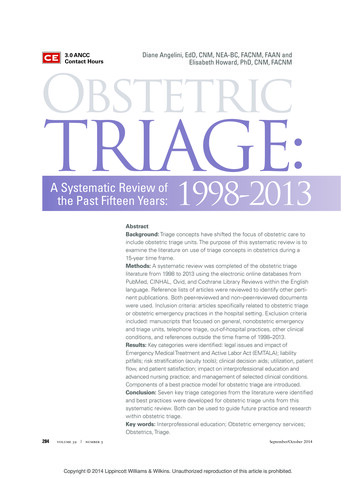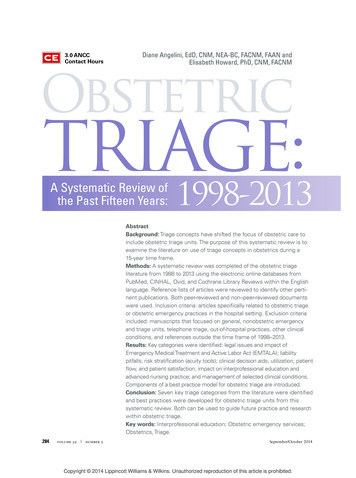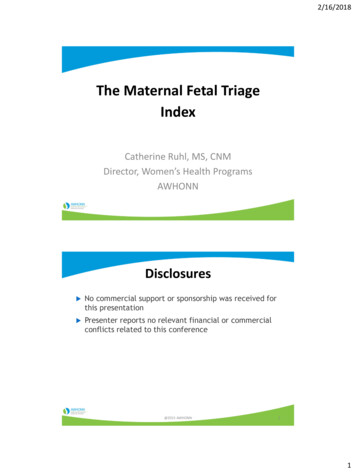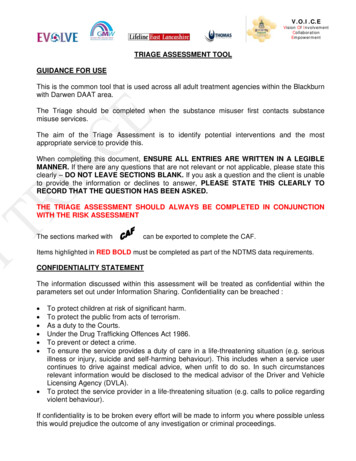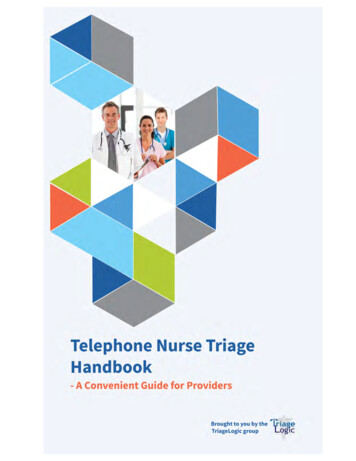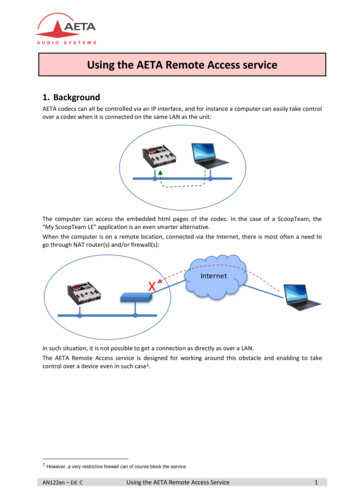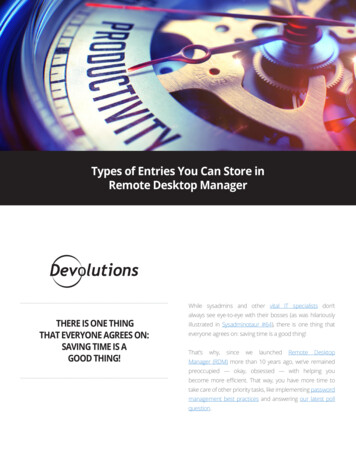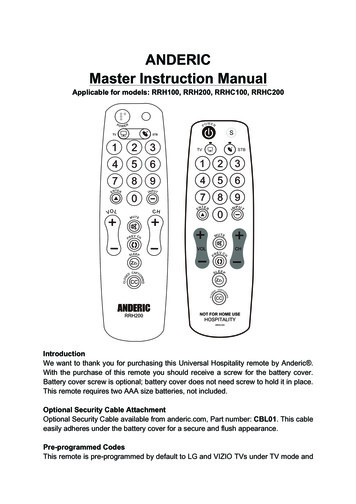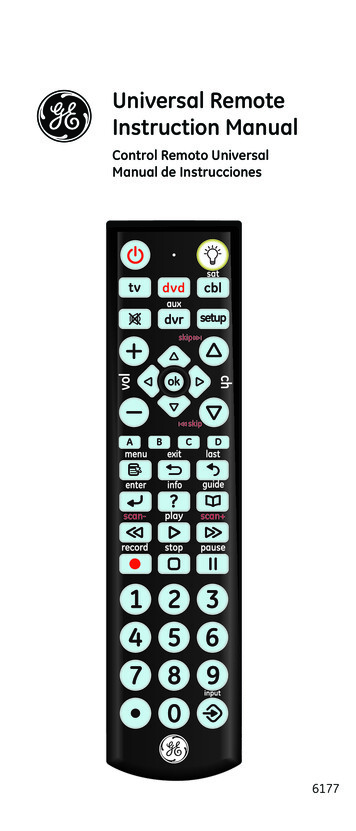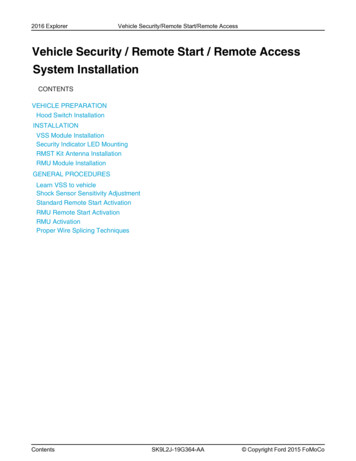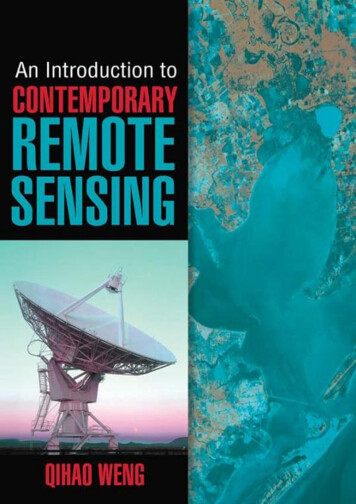
Transcription
4Evidence Synthesis ProgramNOTE: This report is embargoed pendiEffectiveness of Remote Triage:A Systematic ReviewJuly 2019Authors:Prepared for:Department of Veterans AffairsVeterans Health AdministrationHealth Services Research & Development ServiceWashington, DC 20420Prepared by:Evidence Synthesis Program (ESP) CenterDurham VA Healthcare SystemDurham, NCJennifer M. Gierisch, PhD, MPH, Co-DirectorKaren M. Goldstein, MD, MSPH, Co-DirectorPrincipal Investigator:Sharron Rushton, DNP, MS, RN, CCM, CNEJoel C. Boggan, MD, MPHJennifer M. Gierisch, PhD, MPHCo-Investigators:Allison A. Lewinski, PhD, MPH, RNAdelaide M. Gordon, MPHJohn Paul Shoup, MDElizabeth Van Voorhees, PhDJohn D. Whited, MDAmir Alishahi Tabriz, MD, MPH, PHDSoheir Adam, MDJessica Fulton, PhDAndrzej S. Kosinski, PhDMegan G. Van Noord, MSISJohn W. Williams Jr., MD, MHScKaren M. Goldstein, MD, MSPHResearch Associates:Avishek Nagi, MSBelinda Ear, MPHRobyn E. Fortman, BALiz Wing, MA4
Effectiveness of Remote TriageEvidence Synthesis ProgramPREFACEThe VA Evidence Synthesis Program (ESP) was established in 2007 to provide timely and accuratesyntheses of targeted health care topics of importance to clinicians, managers, and policymakers as theywork to improve the health and health care of Veterans. These reports help: Develop clinical policies informed by evidence; Implement effective services to improve patient outcomes and to support VA clinical practiceguidelines and performance measures; and Set the direction for future research to address gaps in clinical knowledge.The program is comprised of four ESP Centers across the US and a Coordinating Center located inPortland, Oregon. Center Directors are VA clinicians and recognized leaders in the field of evidencesynthesis with close ties to the AHRQ Evidence-based Practice Center Program and CochraneCollaboration. The Coordinating Center was created to manage program operations, ensuremethodological consistency and quality of products, and interface with stakeholders. To ensureresponsiveness to the needs of decision-makers, the program is governed by a Steering Committeecomprised of health system leadership and researchers. The program solicits nominations for reviewtopics several times a year via the program website.Comments on this evidence report are welcome and can be sent to Nicole Floyd, Deputy Director, ESPCoordinating Center at Nicole.Floyd@va.gov.Recommended citation: Rushton S, Boggan JC, Lewinski AA, Gordon AM, Shoup JP, Van VoorheesE, Whited JD, Alishahi Tabriz A, Adam S, Fulton J, Kosinski AS, Van Noord MG, Williams JW Jr,Goldstein KM, Gierisch JM. Effectiveness of Remote Triage: A Systematic Review. Washington, DC:Evidence Synthesis Program, Health Services Research and Development Service, Office of Researchand Development, Department of Veterans Affairs. VA ESP Project #09-010; 2019. Available sp/reports.cfm.This report is based on research conducted by the Evidence Synthesis Program (ESP) Center located at theDurham VA Healthcare System, Durham, NC, funded by the Department of Veterans Affairs, Veterans HealthAdministration, Office of Research and Development, Quality Enhancement Research Initiative. This work wassupported by the Durham Center of Innovation to Accelerate Discovery and Practice Transformation (ADAPT) (CIN13-410) at the Durham VA Health Care System. The findings and conclusions in this document are those of theauthor(s) who are responsible for its contents; the findings and conclusions do not necessarily represent the viewsof the Department of Veterans Affairs or the United States government. Therefore, no statement in this article shouldbe construed as an official position of the Department of Veterans Affairs. No investigators have any affiliations orfinancial involvement (eg, employment, consultancies, honoraria, stock ownership or options, expert testimony,grants or patents received or pending, or royalties) that conflict with material presented in the report.i
Effectiveness of Remote TriageEvidence Synthesis ProgramACKNOWLEDGMENTSThis topic was developed in response to a nomination by Jennifer MacDonald, MD, Office ofConnected Care for the purpose of developing an enterprise master plan for clinical contactcenter optimization. The scope was further developed with input from the topic nominators (ie,Operational Partners), the ESP Coordinating Center, the review team, and the Technical ExpertPanel (TEP).In designing the study questions and methodology at the outset of this report, the ESP consultedseveral technical and content experts. Broad expertise and perspectives were sought. Divergentand conflicting opinions are common and perceived as healthy scientific discourse that results ina thoughtful, relevant systematic review. Therefore, in the end, study questions, design,methodologic approaches, and/or conclusions do not necessarily represent the views ofindividual technical and content experts.The authors gratefully acknowledge Chad Kessler, MD, National Program Director, EmergencyMedicine, Veterans Health Administration for his help, Eric Monson, PhD, for his help with datavisualization and the following individuals for their contributions to this project:Operational PartnerOperational partners are system-level stakeholders who have requested the report to informdecision-making. They recommend TEP participants; assure VA relevance; help develop andapprove final project scope and timeframe for completion; provide feedback on draft report; andprovide consultation on strategies for dissemination of the report to field and relevant groups.Jennifer MacDonald, MDClinical LeadOffice of Connected CareTechnical Expert Panel (TEP)To ensure robust, scientifically relevant work, the TEP guides topic refinement; provides inputon key questions and eligibility criteria, advising on substantive issues or possibly overlookedareas of research; assures VA relevance; and provides feedback on work in progress. TEPmembers are listed below:Becky Yano, PhD, MSPHDirector, VA HSR&D Center for the Study of Healthcare Innovation, Implementation & PolicyDeputy Associate Chief of Staff (ACOS) for Health Services ResearchVA Greater Los Angeles Healthcare SystemPeter Kaboli, MD, MSChief of MedicineIowa City VA Health Care SystemDanielle Rose PhD, MPHCore InvestigatorVA Greater Los Angeles Healthcare Systemii
Effectiveness of Remote TriageEvidence Synthesis ProgramPeer ReviewersThe Coordinating Center sought input from external peer reviewers to review the draft report andprovide feedback on the objectives, scope, methods used, perception of bias, and omittedevidence. Peer reviewers must disclose any relevant financial or nonfinancial conflicts ofinterest. Because of their unique clinical or content expertise, individuals with potential conflictsmay be retained. The Coordinating Center and the ESP Center work to balance, manage, ormitigate any potential nonfinancial conflicts of interest identified.iii
Effectiveness of Remote TriageEvidence Synthesis ProgramTABLE OF CONTENTSExecutive Summary . 1Introduction . 1Methods. 2Results . 3Certainty of Evidence for Primary Outcomes of Effect of Remote Triage . 5Themes of Best Practice Considerations for Remote Triage . 7Instances of Themes in Phase and Aspect Categories . 8Discussion . 9Abbreviations Table . 11Evidence Report . 12Introduction . 12Methods. 14Topic Development . 14Key Questions . 14Search Strategy . 14Study Selection . 15Data Abstraction . 17Quality Assessment . 18Data Synthesis. 19KQ 1—Effects of Remote Triage . 19KQ 2—Best Practices for Remote Triage . 19KQ 3—Assessment of Remote Triage . 20Rating the Body of Evidence . 20Peer Review . 20Results . 21Literature Flow. 21Evidence Profile . 22Patterns of Outcome Reporting. 24KQ 1—Effects of Remote Triage . 24KQ 2—Best Practices for Remote Triage . 25KQ 3—Assessment of Remote Triage . 25iv
Effectiveness of Remote TriageEvidence Synthesis ProgramKey Question 1: . 26A. For adults, what are the effects of remote triage on health care utilization,case resolution, patient safety, patient satisfaction, and cost? . 26B. What is the impact of remote triage by different modalities (eg, telephone,video, web, SMS)? . 26Characteristics of Included Studies. 26Effects of Remote Triage on Health Care Utilization: Key Points . 27Detailed Findings . 28Effects of Remote Triage on Case Resolution: Key Points . 33Detailed Findings . 33Effects of Remote Triage on Patient Safety: Key Points . 37Detailed Findings . 37Effects of Remote Triage on Patient Satisfaction: Key Points . 41Detailed Findings . 41Effects of Remote Triage on Cost: Key Points . 44Detailed Findings . 44Quality of Evidence for Key Question 1. 46Key Question 2: What are the identified best practices that impact the planning,execution, and evaluation of remote triage for adults seeking clinical care advicein a large-scale health system such as the VA? . 49Characteristics of Included Studies. 49Remote Triage Best Practices: Key Points . 52Detailed Findings . 52Quality of Evidence for Key Question 2. 63Key Question 3: What are the types of outcomes used to assess the impact of remote triage? 67Key Point . 67Detailed Findings . 67Summary and Discussion . 71Key Question 1 Summary . 71Key Question 2 Summary . 74Key Question 3 Summary . 75Prior Systematic Reviews . 75Clinical and Policy Implications . 75Limitations . 77Publication Bias . 77Study Quality . 77v
Effectiveness of Remote TriageEvidence Synthesis ProgramHeterogeneity . 77Applicability of Findings to the VA Population . 77Research Gaps/Future Research . 78Conclusions . 79References . 80TABLESTable 1. Eligibility Criteria . 15Table 2. Evidence Profile for Studies of Remote Triage Interventions for Adults. 22Table 3. Definitions of Remote Triage Comparison Types . 24Table 4. Framework for Organizing Best Practice Considerations for Remote Triage . 25Table 5. Overview of KQ 1 studies . 26Table 6. Summary of Utilization Outcomes in Remote Triage Studies . 31Table 7. Summary of Case Resolution Outcomes in Remote Triage Studies . 36Table 8. Summary of Patient Safety Outcomes in Remote Triage Studies . 40Table 9. Summary of Patient Satisfaction Outcomes in Remote Triage Studies. 43Table 10. Summary of Cost Outcomes in Remote Triage Studies . 45Table 11. Themes of Best Practice Considerations for Remote Triage . 49Table 12. Description of Metrics for KQ 3 . 68Table 13. Certainty of Evidence for Primary Outcomes of Effect of Remote Triage . 73Table 14. Evidence Gaps and Future Research . 78FIGURESFigure 1. Literature Flow Diagram for KQ 1 and KQ 3 . 21Figure 2. Literature Flow Diagram for KQ 2 . 22Figure 3. Effects of Remote Triage on Utilization of Primary Care Services . 29Figure 4. Effects of Remote Triage on Utilization of Emergency Department Services . 31Figure 5. Effects of Remote Triage on Cases Triaged to Primary Care . 35Figure 6. Effects of Remote Triage on Cases Resolved on Initial Contact . 36Figure 7. Effects of Remote Triage on Patient Deaths . 38Figure 8. Effects of Remote Triage on Hospitalizations. 39Figure 9. Effects of Remote Triage on Emergency Department Visits . 39Figure 10. Effects of Remote Triage on Patient Satisfaction. 42Figure 11. Effects of Remote Triage on Cost . 45vi
Effectiveness of Remote TriageEvidence Synthesis ProgramFigure 12. Risk of Bias Ratings for the Included EPOC Studiesa . 47Figure 13. Risk of Bias Ratings for the Included Interrupted Time-Series Studya . 48Figure 14. Risk of Bias Assessment Across Included EPOC Studiesa . 49Figure 15. Heat Map: Number of Studies by Phase, Aspect, and Theme. 51Figure 16. Risk of Bias Ratings for the Included Qualitative Studiesa . 64Figure 17. Risk of Bias Ratings for the Included Systematic Reviewa Studiesb . 65Figure 18. Risk of Bias Assessment Across Included Qualitative Studiesa. 66Figure 19. Risk of Bias Assessment Across Included Systematic Review Studiesa. 66Appendix A. Search Strategies . 87Appendix B. Intervention Characteristics Tables . 89Appendix C. Study Characteristics Tables . 100Appendix D. Excluded Studies . 114Appendix E. Peer Review Comments and Response Table . 147Appendix F. Glossary . 151vii
Effectiveness of Remote TriageEvidence Synthesis ProgramEXECUTIVE SUMMARYINTRODUCTIONThe US health care system currently faces several challenges including caring for an increasingelderly population, a large numbers of patients with multiple chronic conditions, and an unevendistribution of primary care providers across the country. The full appointment schedules ofmany primary care physicians compound this workforce shortage, making it challenging formany patients to access acute and chronic care within a primary care setting. Additionally, manypatients experience multiple structural, financial, and logistical barriers to receiving timely care.In rural areas, for example, patients face challenges posed by distance to providers, decreasednumbers of providers, and a lack of public transportation infrastructure to facilitate attendingappointments.Such access challenges may lead people to seek acute or chronic care in settings such asemergency departments (EDs) when their needs could have likely been addressed in a primarycare setting. Increasingly, acute care visits take place outside of the primary care setting. Yetpatients who have access to after-hours care at their usual primary care practice have lower ratesof higher level care utilization. One way of providing patient access to the appropriate level ofcare is through technology-based systems that facilitate remote decision-making. Remotedecision-making is defined as making clinical decisions in the absence of a face-to-faceencounter. Further, remote decision-making can overcome barriers such as demand for in-personclinical services.The implementation of any technology-based system is complex and requires evaluation of manyfactors at the patient, provider, and organizational levels. Factors related to the successfulplanning of such a system include the specific clinical and population contexts, the ability tosustain the process, and legal considerations around remote medical decision-making. Specificissues related to the execution of such a system include adaptability, complexity of the system,costs, external forces like incentives, and internal forces like supportive resources. Such systemshave been successfully implemented in the United Kingdom, where patients requesting a sameday appointment by telephone are assessed and triaged to the appropriate level of care. Priorsystematic reviews have reported that more research is necessary to determine the impact oftriage and telephone consultation with patients on clinical outcomes, costs, and subsequent careutilization.As the country’s largest integrated health system, the Veterans Health Administration (VHA) hasa mandate to care for Veterans across the entire United States and associated territories. Veteransestablished within VA may still experience barriers to accessing care, including multiple healthcomorbidities that limit travel, transportation concerns, or the need to access care after normalprimary clinic hours. Thus, technology-based solutions to improve access are of significantinterest in meeting VA’s responsibility “to care for [those] who shall have borne the battle.”Additionally, the recently passed MISSION Act specifically identifies telehealth via telephone orcomputer as channels for Veterans to receive timely care. At the request of the VA Office ofConnected Care, we therefore conducted a systematic review to address the following keyquestions (KQs):1
Effectiveness of Remote TriageEvidence Synthesis ProgramKQ 1:A. For adults, what are the effects of remote triage on health care utilization, case resolution,patient safety, patient satisfaction, and cost?B. What is the impact of remote triage by different modalities (eg, telephone, video, web,short message service [SMS])?KQ 2: What are the identified best practices that impact the planning, execution, and evaluationof remote triage for adults seeking clinical care advice in a large-scale health system suchas the VA?KQ 3: What are the types of outcomes used to assess the impact of remote triage?METHODSWe developed and followed a standard protocol for this review in collaboration with operationalpartners and a Technical Expert Panel (PROSPERO registration number CRD42019112262).Data Sources and SearchesWe searched MEDLINE (via PubMed ), EMBASE, and CINAHL, from inception through July27, 2018. We conducted one primary literature search for KQ 1 and KQ 3 and a different searchfor KQ 2. We also examined the bibliographies of recent reviews for additional relevant studies.Study SelectionIn brief, the major eligibility criteria for KQ 1 and KQ 3 were randomized or nonrandomizedstudies of remote triage services that reported health care utilization, case resolution, patientsafety, patient satisfaction, or cost outcomes. For KQ 2, we also included additional qualitativestudies, mixed-method studies, organizational case studies, and systematic reviews addressingbest practices for implementing remote triage. Remote triage services were defined as servicespertaining to the initial assessment and management of acute, undifferentiated, or unscheduledcare that were initiated by a patient or family member from a distance and were focused on aclinical care issue. Using prespecified inclusion/exclusion criteria, investigators and theDistillerSR Artificial Intelligence tool (DistillerSR; Evidence Partners Inc., Manotick, ON,Canada) evaluated titles and abstracts to identify potentially eligible studies. Studies that met alleligibility criteria at full-text review were included for data abstraction.Data Abstraction and Quality AssessmentKey characteristics abstracted for KQ 1 were patient descriptors (eg, age, sex, insurance type),intervention characteristics (eg, triage professional type, delivery modality, key triage systemcharacteristics, decision protocols or support software), comparator, and outcomes. For studiesrelevant to KQ 2, we abstracted emerging practices for the implementation of remote triageservices including insights into personnel, processes, and technologies needed to establishremote triage and implications for what works well and what does not in delivering remote triageservices. For KQ 3 we abstracted the measures and metrics used to evaluate remote triagesystems.For KQ 1 and KQ 3 studies, we assessed risk of bias (ROB) using the Effective Practice andOrganization of Care (EPOC) guidance. For KQ 2 studies, we used ROB appraisals customized2
Effectiveness of Remote TriageEvidence Synthesis Programto the specific study design. Summary ROB ratings could only be assessed using the EPOC tooland are defined as follows: low ROB is assigned to studies where bias, if present, is unlikely toalter the results seriously; unclear ROB is assigned to studies where the risk of bias raises somedoubts about the results; and high ROB implies that bias may alter the results seriously.Data Synthesis and AnalysisFor KQ 1, we describe the included studies using summary tables and graphical displays. Wewere unable to compute summary effects (ie, meta-analysis) because of conceptuallyheterogeneous studies. Thus, we analyzed the data narratively. We gave more weight to theevidence from higher quality studies with more precise estimates of effect. When possible, wepresent forest plots of the point estimates of individual studies, grouped by the overall type ofcomparison drawn in each study.We analyzed potential reasons for inconsistency in treatment effects across studies by evaluatingdifferences in the study population, intervention, comparator, and outcome definitions. Certaintyof evidence (COE) was assessed for outcomes critical to decision-making using the approachdescribed by the Grading of Recommendations Assessment, Development and Evaluationworking group (GRADE).For KQ 2, 3 co-investigators (JMG, AAL, SR) with experience in qualitative methodology ledthe abstraction and analysis of data collected. Using the KQ 2 question as a guide, we created ana priori framework developed in collaboration with our stakeholders and Technical ExpertPanel. This framework included 3 phases of emerging practices: planning, execution, andevaluation, and 3 aspects of emerging practices: people, processes, and technology. The creationand identification of codes and themes were iterative; to ensure rigor and validity of thesefindings, the 3 co-investigators independently coded and then discussed the codes, definitions foreach code, and the themes until they reached consensus.For KQ 3, we categorized the types of metrics used to evaluate the impact of remote triageservices reported by studies that met inclusion criteria for KQ 1. We adapted 6 categoriesdeveloped by Carrasqueiro et al: (1) enhanced access to care; (2) change in rates or trends ofservices use or change in professionals’ workload; (3) adverse events (deaths, emergencydepartment attendance, hospital admissions) and delayed care; (4) clinical outcomes after triage;(5) patient satisfaction measured via Likert scales; and (6) savings from avoided services use andtriage costs.RESULTSResults of Literature SearchThe literature search identified 5,026 articles relevant to KQ 1 and KQ 3 and 6,911 articlesrelevant to KQ
Effectiveness of Remote Triage: A Systematic Review . Authors: Principal Investigator: . Implement effective services to improve patient outcomes and to support VA clinical practice guidelines and performance measures; and . many patients to access acute and chronic care within a primary care setting. Additionally, many .
